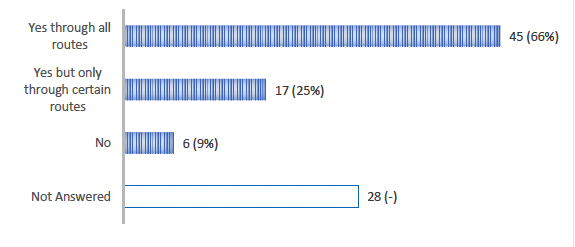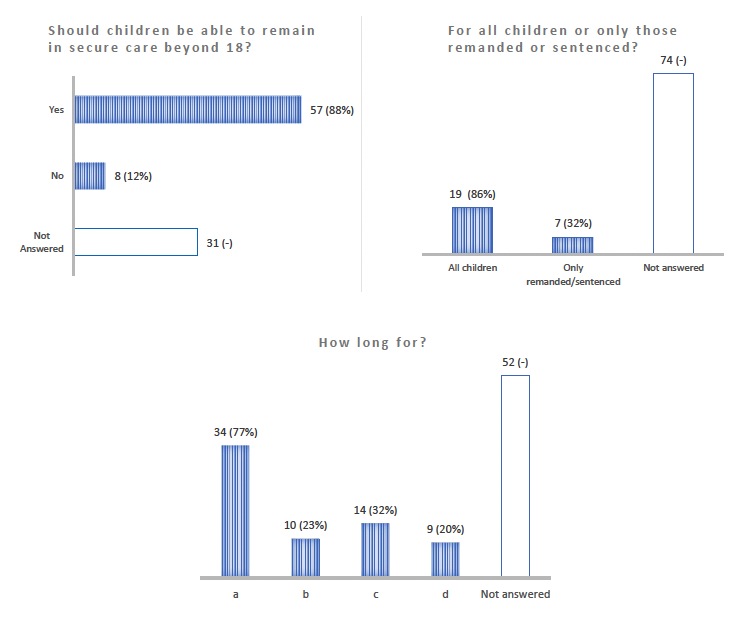Children's Care and Justice Bill - policy proposals: consultation analysis
The Children’s Care and Justice Bill consultation was published on 30 March 2022 seeking views and feedback on policy proposals to inform the development of the Bill. 106 responses were received from a broad range of stakeholders. This document provides full analysis of those responses.
5. Pillar Three: Secure Care
Question 14
Do you agree that the regulatory landscape relating to secure care needs to be simplified and clarified?
Yes / No
Please give reasons for your answers
If yes, please provide details of how this could be achieved

Statistical overview
- Ninety-four percent of respondents agreed that the regulatory landscape of secure care needs to be simplified and clarified
- Only three respondents disagreed with this question, including two individuals and one Secure Care Centre
Main themes
Many responses highlighted that the current regulatory landscape of secure care was highly complex and confusing. Local Government/Social Work and Third Sector respondents in particular noted that the legal complexities surrounding whether a child is able to access secure care (especially where they are 16 or 17 and not on a CSO) has led to differing interpretations across agencies and unequal access for children and young people. One Local Government/Social Work respondent highlighted that they often must seek independent legal advice to determine whether a child is able to be placed in secure. These respondents also stressed the funding of secure care exacerbated complexities, with secure places funded by local authorities with the exception of sentenced children, whose placements were funded by the Scottish Government. This was seen to create perverse incentives for decisions about where a child is to be placed based on resource demands rather than what is in the child's best interests. These respondents argued that a national strategy and funding model, with clear guidance, would be an important improvement - a suggestion that will be discussed in more detail under Question 18.
Furthermore, several respondents highlighted that the regulatory landscape makes it difficult for practitioners to explain to children, their families and victims the decisions being made, and limits their ability to participate in this process.
"The secure landscape is complex. It has complex regulation and complex decision-making routes into and out of secure care. We are of the view that changes could be made to the pathway into and out of secure care which would allow a social worker to describe what will happen more easily to a child and their family."
[Case 82, Children's Hearings Systems-related]
Other responses highlighted that the current complex regulatory landscape could lead to inconsistent practice and scrutiny, with the potential to impact the level of care provided.
"In addition to confusion over the routes that children can take into secure care there are complex mechanisms in place to inspect secure care and other forms of care which restrict a child's liberty. For example, services that are not registered as a secure accommodation service do not receive the same level of scrutiny from the Care Inspectorate as secure care centres. This results in a tiered approach to the upholding of children's rights, with children placed by authorities outwith Scotland into residential settings through Deprivation of Liberty orders, which restrict their freedoms and experiences of care within services that are not being inspected using the quality framework for secure accommodation services."
[Case 68, Children and Young People's Centre for Justice]
Young People
Three young people agreed that the regulatory landscape needs to be simplified and clarified, and one disagreed. Limited qualitative responses were given, with one emphasising that there needs to be more secure facilities in Scotland to manage need.
Question 15
Do you feel that the current definition of "secure accommodation" meets Scotland's current and future needs?
Yes / No
Please give reasons for your answers
If no, please provide details of how this could be changed

Statistical overview
- A significant number of respondents did not answer this question, but of those who did, 73% did not think the definition of secure accommodation met Scotland's current and future needs whilst 27% did
- Organisations were more likely to respond 'no' to this question than individuals (79% compared to 59%)
- All Hybrid Organisations, along with 80% of Representative Groups and 78% of Delivery Organisations responded no. Only two Influencer Organisations responded to this question, of which half responded no.
- All Police, Third Sector and Legal organisations answered no, as did 85% of Local Government/Social Work responses.
- Secure Care Centres were split 50-50 on whether they felt the definition met needs, however the qualitative responses of those who answered yes were supportive of a change in definition should it increase precision and any implementation of these changes be fully resourced.
Main themes
Respondents drew explicit attention to the language of the current definition being at odds with the vision for secure care outlined in The Promise - particularly, in respect of therapeutic, trauma-informed, rights focused and supportive elements of the provision. Similarly, other respondents believed that the current definition of secure accommodation adopted language which could be seen to be stigmatising.
"No. The legal definition should reflect the purpose of what secure care is and its intention. The current definition is grossly outdated, not rights respecting and not child centred."
[Case 86, Good Shepherd Centre]
"There is currently a stigma around the use of 'secure care', which can be viewed as a punishment for children and young people."
[Case 64, Who Cares? Scotland]
A smaller number of respondents did however feel that the definition in its current form was appropriate, whilst a very small number of respondents stated that the rationale for any definition change was unclear.
Young People
Three young people agreed that the current definition of secure accommodation is adequate, and two disagreed. Limited qualitative responses were given to this question, however a key concern expressed in three responses was that secure care should not be used for children who abscond. This reflected concerns outlined in question 6 relating to the criteria for MRCs.
Question 16
Do you agree that all children under the age of 18 should be able to be placed in secure care where this has been deemed necessary, proportionate and in their best interest?
Yes through all routes
Yes but only through certain routes
No
Please give reasons for your answer, including any positive or negative implications

Statistical overview
- Almost two-thirds of respondents felt that secure care should be available to all children under 18 through all routes, whilst 25% felt this should only be through certain routes.
- Organisations were much more likely than individuals to support this being available through all routes, at 81% compared to 30%.
- All Representative Groups felt this should be available through all routes, as did 80% of Hybrid Organisations, 78% of Delivery Organisations and 75% of Influencer Organisations
- Across sector groupings, all Secure Care Centres, Police organisations and Legal organisations felt this should be possible through all routes.
- Only six respondents answered 'no' to this question, including two individual and four organisations
- Of the organisations that responded 'no', three were Delivery Organisations (specifically, two Local Government/Social Work organisations and one Children's Hearings Systems-related organisation) and one Hybrid Organisation (specifically, one Third Sector organisation).
Main themes
While there was generally agreement with this proposal, a number of respondents highlighted the implications for capacity, resource and workforce skills that would follow on from any change to routes to accessing secure care that required careful consideration. This was raised as a concern by almost all organisational respondents.
"As already noted, there are significant funding and resourcing implications for such a significant shift in policy, that could a) potentially increase the possible number of referrals to secure care services and/or b) lead to potential unintended consequences where the available secure care settings are unable to meet specific needs unless there is attention paid to the types of setting and support which will require to be developed to meet the needs of young people with extreme mental distress and/or whose behaviours seriously challenge others and present significant risk of significant harm."
[Case 86, Good Shepherd Centre]
Several respondents also emphasised that 'other alternatives' needed to be explored, before the threshold was reached for a child under the age of 18 years old to be placed within a secure care setting. This was particularly stressed by Local Government/Social Work respondents and Children's Rights organisations, where it was emphasised that in line with the UNCRC, detention should only be used as a last resort.
"Secure care should be reserved for young people who pose an ongoing risk of harm to others. Alternative and suitable approaches, supports and accommodation should be developed for young people at risk due to CSE, self-harm etc. There are gaps in multi-agency safeguarding approaches for young people in the community and these could be strengthened as could the provision of emotional and mental health supports."
[Case 12, Local Government/ Social Work]
"We urge a focus on early intervention and community-based alternatives which can prevent the need for secure care."
[Case 71, CELCIS]
Likewise, other respondents emphasised that any decision to place a child in secure care should be subject to robust assessment and safeguards and always align with the best interests of the child.
"When a decision is made to place a child in secure care, their best interests must be the paramount consideration and this decision should be based on an individual human rights assessment for each child. Secure care should be an option where it is in a child's best interests or necessary to prevent others from a significant risk of harm, but given the grave interference in human rights involved, the use of secure care as a disposal should be rare and carefully monitored."
[Case 39, Children and Young People's Commissioner for Scotland]
A very small number of respondents did feel that use of a YOI could still be an appropriate option in certain circumstances. One Victim organisation also argued that 'public safety' should be added to the criteria for determining whether secure is appropriate, where they should be placed in the best appropriate setting to limit risk to the public.
Young People
Eight young people who responded to this question supported it, with five agreeing this should only be for certain routes, three agreeing it should be for all routes, and none disagreeing. Several respondents emphasised that secure care deprived children of their liberty, and thus should only be used as a last resort when all other community alternatives have been exhausted. In this instance, where the child was at high risk to themselves or others, several young people highlighted that secure should be available to all, as a more child-friendly space suited to their age and stage:
"Evidence tells us that brain development continues until the age of 26. Prior to full brain development this can result in increased impulsivity, lack of empathy, and an inability to consider consequences of behaviour. STARR also acknowledges that many young people face multiple traumatic events in their lives and this can manifest in different ways. Therefore, STARR believes that secure care should be an option for all children and young people where appropriate and once all community alternatives have been exhausted."
[Case 102, STARR]
One young person expressed that as secure constituted a deprivation of liberty it should be time-bound, with children and young people aware of when they would be released. Another young person argued instead that it should be more open-ended, and available for as long as the child or young person needs it.
Question 17
Should the costs of secure care placements for children placed on remand be met by Scottish Ministers?
Yes / No
Please give reasons for your answer

Statistical overview
- Respondents overwhelmingly believed that the costs of secure care placements for children placed on remand should be met by Scottish Ministers, with 90% agreeing
- Only six respondents disagreed with this proposal, of whom five were individuals and one was a Hybrid Organisation that had been classified as 'Other'. All other organisations that responded to this question supported this proposal.
Main themes
The principal theme emphasised by multiple respondents was that this proposal would help promote needs-led decision-making, over decision-making that was driven by resources or finances, by taking the financial burden away from local authority budgets. Likewise, it was suggested it would also help in promoting consistent availability of secure care across Scotland, rather than a 'postcode lottery' of places. This proposal was strongly supported by Local Government/Social Work respondents.
"We agree with the view in the consultation that it is important to ensure decisions as to where a child is placed are driven by the needs of the child as opposed to financial considerations..."
[Case 82, Children's Hearings Systems-related]
"Local authorities are always tight for money and the decision not to put a young person into care is obviously financially driven at times!"
[Case 7, Individual]
"Drain on local authority budget could be a disincentive to place children in secure care – this proposal rightly takes cost out of the equation."
[Case 15, Stirling Council]
"The discretion and financial consideration placed on local authorities impacts on consistency in the decision making process across authorities. YP experience a post code lottery."
[Case 53, Secure Care Centre]
A small number of respondents did however highlight that they believed funding should stay with local authorities (for example, via ring fenced funding), with one Local Government/Social Work respondent raising concerns that the proposal would lead to a reduction in local authority budgets. Relatedly, a number of responses also asked for further clarity around how Scottish Ministers would meet the cost of this proposal.
Young People
Five young people supported this proposal and three did not. This represented a considerably lower % of support than the adult respondents (63% compared to 94%). Several respondents raised concerns that secure placement decisions are currently driven by resource rather than the child's welfare, with local authorities not sending children to secure to avoid paying for it. It was thought centralising funding might resolve this. Conversely, some young people felt that local authorities had a better understanding of local need, and it should therefore be funded and managed by them:
"I think it should be paid for by the council – they have a better understanding and involvement in of local matters."
[Case 90, Individual Young Person]
"It's nothing to do with Scottish Ministers. It's social work and it's about what's happening locally, in the council. It's better being handled by the council. If the government get involved they'll put loads of people in who don't understand the situation and it'll affect the quality."
[Case 91, Individual Young Person]
Question 18
Is a new national approach for considering the placement of children in secure care needed?
Yes / No
Please give reasons for your answer
If yes, please provide details of what this approach should look like

Statistical overview
- This proposal received similarly high support as Question 17, with 90% of respondents agreeing that a new national approach for considering the placement of children in secure care was needed
- Only six respondents disagreed with this proposal, including four individuals, one Local Government/Social Work organisation and one Children's Hearings Systems-related organisation
Main themes
Many respondents believed a new national approach for considering the placement of children in secure care to be necessary based upon the consistency that it would offer, along with the associated benefits resulting from centralised monitoring and data practices.
"There are concerns around consistency of thresholds for decision making. There is also no cohesive and holistic overview of the impact, experiences and outcomes for children who are being considered for, are in, or are leaving secure care. The Promise calls for planning and provision to be based on understanding of need and data and the previous Justice Committee noted the lack of a centralised monitoring system for the number of places or referrals to secure care. Within current approaches, such monitoring and data provision is impossible."
[Case 13, Clackmannanshire Council]
"...A national approach with an oversight of availability might see a reduction in the competition between local authorities to access available secure spaces. A process of matching children to the resource that would best meet their needs and ensuring that enough resource is commissioned would be a step in the right direction to support children in the greatest need of support. A national, multi-agency screening panel that authorises decisions about secure care and contributes to resource matching and allocation could improve consistency, and lead to fairer allocation of resource..."
[Case 50, Local. Government / Social Work Related]
However, several respondents did highlight the significance of the localised dimension in any consideration of the proposal, particularly around how local knowledge and expertise, along with understanding of resources, would sit within or alongside a national approach. This was particularly stressed by Local Government/Social Work respondents.
"There needs to be a more cohesive approach to placing children in secure care however would worry about a national body making decisions across the board. Local Authorities have the knowledge and understanding of the child and family locally and will have built relationships. LA's will also know what resources and supports are available to consider community alternatives and to plan for a return home after a period of time in secure care."
[Case 81, Local Government /Social Work Related]
A number of respondents did feel that further scoping and exploration needed to be carried out before any decision around a national approach was implemented.
Young People
Six young people agreed with this proposal and only one disagreed. Two key reasons were expressed for why a new national approach should be implemented. One aspect, closely related to the previous question, arose from concern that current placement decisions are driven by resource needs, rather than children's welfare. It was suggested that there should be clearer criteria for referrals to secure care, and that this should be implemented and monitored nationally to create consistency across Scotland. Two responses suggested this should be undertaken by an independent or separate agency or professional, who can:
"...act as a central point of contact for referrals to secure care – this would mean that there is a more consistent approach to referrals (which could still include the Chief Social Work Officer of the respective local authority and the head of service of each secure care centre). This role could include assessing referrals to find the most appropriate placement for the child who has been referred, taking into account their needs and views."
[Case 102, STARR]
Furthermore, young people also highlighted that a new national approach would facilitate consistency in the quality and availability of support services across Scotland in both secure and in the community. One response highlighted how secure centres are currently run independent of each other, leading to significant differences in terms of children's experiences and limitations in secure.
Question 19
Is provision needed to enable secure transport to be utilised when necessary and justifiable for the safety of the child or others?
Yes / No
Please give reasons for your answer

Statistical overview
- This proposal received one of the highest levels of support across the consultation, with 95% of respondents agreeing that provision was needed to enable secure transport to be utilised when necessary and justifiable
- Only three respondents disagreed with this proposal, including two individuals and one Local Government/Social Work organisation
Main Themes
Respondents raised various concerns with the current provision of secure transport in Scotland. Key to these concerns was the inconsistent availability of secure transport at the point of need. This was identified as a widespread problem, but with some respondents stressing that it posed a particular issue for rural areas and Scottish islands. Respondents, including Local Government/Social Work and Police-related organisations, highlighted that the lack of availability led to children and young people often waiting for unacceptable periods of time, exacerbating feelings of distress and anxiety. Whilst it was often difficult to forward-plan for journeys, even where transport had been organised in advance, it was often delayed
"It is clear that secure transport is not available across the country, at the point of need for children. This need cannot always be anticipated, but even when planning is possible, we know of many cases of unacceptable delay."
[Case 22, Police Scotland]
Local Government/Social Work and Secure Care Centre respondents provided examples of situations where the lack of secure transport meant children were unable to be transported at all or had to be transported alongside adult prisoners or in police vehicles. One respondent highlighted that children in secure were having to attend their hearings remotely, even though they had the right to attend in person.
Moreover, respondents highlighted that without a national provider of secure transport local authorities needed to 'spot purchase' from private providers, often at great expense. Respondents raised concerns that these providers often cannot meet the care needs of children and young people, with staff not trauma-informed, physical restraints used unnecessarily and communication between providers and children inadequate.
This leads to some children being transported in situations which are not acceptable or child centred, and which cause additional trauma to the child. This includes amongst others, use of restraint, not having a familiar person with them, and lack of appropriate knowledge of the child's needs and circumstances by those undertaking the transport. Feedback from children confirms that this is a scary and difficult process which adds to their distress.
[Case 25, Social Work Scotland]
Unfortunately, we know that some providers do not treat children with the respect and dignity that they deserve, often using restraint to deal with challenging behaviour. Shockingly, many children find that they are automatically put in handcuffs by their transportation provider. A child does not need to be considered "high risk" to be put in handcuffs: a child who displays even the slightest sign of distress risks being subject to handcuffs o other forms of restraint.
[Case 17, Serenity Welfare]
For these reasons, the vast majority of respondents agreed that provision is needed to enable secure transport to be utilised. Respondents provided various suggestions and considerations for how provision could be enhanced and improved. Several argued that national standards were needed, with providers monitored and regulated to ensure they meet the needs and respect the rights of children and young people. It was highlighted that this could be based on the secure transport specification that is currently being prepared by the Secure Transport Working Group.
"The current model means there are no standards or regulation around the provision of transport resulting in varying experiences for young people..."
[Case 66, COSLA]
It was also proposed that secure transport could be based in secure centres, which would increase the availability of transport whilst allowing children and young people to get to know staff who would be specifically trained to support them. Several respondents also emphasised that whilst secure transport provision should be increased, this should still only be used as a last resort, with processes sufficiently flexible to allow children and young people to be transported by people they know where this is deemed appropriate and safe. One Local Government/Social Work organisation disagreed with this proposal. They argued that wherever possible, children must be accompanied by secure staff or other people they know, and that when security was needed this should be provided by Police Scotland.
Young People
Six young people agreed that provision was needed to enable secure transport to be used when necessary and justifiable, and one disagreed. Young people stressed that whilst each child in secure is different, with different needs, where a child poses a significant risk to others then secure transport should be available for them. Furthermore, it was felt secure transport helped to protect the privacy of the child. Despite this, several responses emphasised that the current model of secure transport was detrimental to the child and can be a traumatising and stigmatising experience. It was suggested that secure transport could be changed to resemble a 'normal' vehicle as much as possible, that this should never be a police vehicle, and that regulations could be altered to allow children to be accompanied by family members of carers where appropriate. Young people made other suggestions for secure transport, which will be discussed under Question 20.
Question 20
Are there any other factors that you think need to be taken into account in making this provision for secure transport?
Yes / No
Please give reasons for your answer
If yes, please provide details of these factors

Statistical overview
- A large number of respondents did not answer this question. Of those who did, 69% said yes and 31% said no.
- Individuals were less likely to respond yes, at only 50% compared to 83% of organisations
- All Influencer Organisations, Hybrid Organisations and Representative Groups responded yes to this question, as did 77% of Delivery Organisations
- Within most sector groupings, 100% of respondents answered yes, with the exception of five Local Government/Social Work organisations and one Children's Hearings Systems-related organisation
Main Themes
Many of the responses to this question reflected answers provided to Question 19. This included the need for secure transport provision to be regulated, for staff to be trauma-informed and for no unnecessary use of restraint. In addition, several respondents raised concerns regarding how secure transport should be funded going forward, arguing that the current process of 'spot purchasing' from providers was expensive and unsuitable. This was particularly stressed by Local Government/ Social Work respondents. These respondents proposed that the Scottish Government should meet the cost of secure transport, through a national contract that can provide consistently available transport across Scotland.
The Scottish Government should meet the cost for secure transport as it operates a contract for adults. The service should be regulated and promote the rights of the child delivering in the manner outlined in the Secure Care Pathway and Standards. Someone the child knows should accompany them on their journey. Workers should be trained in trauma informed practice and create a safe and respectful space when travelling. No mechanical restraints should be used.
[Case 81, Local Government/ Social Work]
In addition to concerns regarding the funding of secure transport, various other factors were cited by respondents, including that:
- Children should be accompanied by a trusted adult during their journey
- Attention should be given to the age and stage of the child and any developmental needs they might have
- Secure transport must be made available to rural and island communities
- Journeys can often be long, and the impact on this for the child should be taken into account.
Young People
Seven young people responded to this question with factors they felt should be taken into consideration. It was highlighted that decisions on who needs to be transported securely should be professionally risk assessed and take into consideration the potentially negative impact that it can have on the child's mental health and self-esteem.
"I think they need to think carefully about the child's mental health. If they're not dangerous then secure transport shouldn't be used as it might affect their mental health and make them think they're dangerous or that other people think of them as dangerous. It might affect their confidence or how they see themselves."
[Case 96, Individual Young Person]
Furthermore, it was suggested that wherever possible children should be transported by or with someone they know, and if not someone from the centre should accompany them. Two respondents argued that restraint should never be used during these journeys, and one responded that communication to children and young people during these journeys had to be significantly improved, citing concerns that children are often currently ignored by secure transport workers and have no idea where they are getting taken to:
"We are aware of instances where children have experienced a dehumanising secure transport experience where staff involved refuse to communicate with the children. All staff involved in secure transport and secure care admission should be appropriately trained so that they have an understanding of adverse childhood experiences and trauma. This should be something that is specific to the roles of secure care transport and admissions, rather than staff being trained within adult prisons or subcontracting staff from private security operators."
[Case 102, STARR]
Question 21
Do you agree children should be able to remain in secure care beyond their 18th birthday, where necessary and in their best interests?
Yes / No
If yes, for all children or only those who are remanded or sentenced?
If yes, how long for?
a) For as long as the child's needs require it
b) To a maximum length of remand or sentence (and if so what should this be?)
c) To a maximum age (and if so what should this be?)
d) For another period (please specify)
Please give reasons for your answers

Statistical overview
- This question had three aspects. The first of which allowed respondents to answer yes or no, whilst the second and third aspects allowed respondents to select multiple options
- A significant majority of respondents felt children should be able to remain in secure care beyond their 18th birthday, with 88% agreeing and 12% disagreeing
- Individuals were less likely to support this proposal, with 74% agreeing, compared to 93% of organisations
- Of the three organisations who disagreed, all three were Delivery Organisations. More specifically these included one Children's Hearings Systems-related organisation, one Local Government/Social Work organisation and one Secure Care Centre.
- For the second aspect of this question, the vast majority did not provide a response. Of those that did, 19 felt that secure care should be available for all children beyond their 18th birthday, and only seven felt this should only be for children who have been remanded or sentenced. Notably, a small number of respondents selected both options.
- For the third aspect of this question, which asked respondents how long secure care should be available for, again, the majority did not provide a response. Of those that did, the most popular option was for secure care to be available for as long as the young person needs it, with 77% of respondents selecting this.
Main Themes
Many respondentsfelt robust planning and risk assessment, along with a case-by-case or individualised approach, to be important when considering whether a child should remain in secure care beyond their 18th birthday.
"We would support the proposal that children who turn 18 could remain in secure care in specific circumstances and for a time limited period, when this is considered necessary and in their best interests. This should be based on assessment of their needs, strengths, risks and vulnerabilities and made on a case-by-case basis. Decisions should be limited to children who are remanded or sentenced and whose liberty requires to be deprived on an ongoing basis."
[Case 28, HM Inspectorate of Constabulary]
"... secure care should be available for people beyond 18 in certain circumstances. We believe that a risk-based approach should be adopted and the individual facts and circumstances of the harm the child is exhibiting should be a primary consideration as to where the child should stay. Where the public's safety through crime or harm caused by the child is at risk then they should be placed in the most appropriate setting to mitigate that risk."
[Case 19, Third Sector]
Several respondents highlighted the importance of developmental factors in any consideration of whether a child should be able to remain in secure care beyond their 18th birthday.
"To recognise those whose chronological age and emotional/functional ages are misaligned/delayed/impaired. To take account of latent vulnerabilities including autism and ID."
[Case 105, ARCH Parent and Carer Focus Group]
"Responding to a young person's needs should be less about chronological age and more about their age and stage of development. Our understanding of maturation and brain development has altered and our services need to be responsive to these developments. System barriers at present could prevent ongoing continuity of an important intervention or prevent an intervention from being introduced due to timescales and age rather than a person's needs."
[Case 12, Local Government / Social Work]
Most respondents believed that a child should be able to stay in secure care beyond their 18th birthday up until age 21 years old. There were also reference to it being up to 26 years old. Other responses believed the period should be set at three months or 12 months after a child's 18th birthday. One respondent believed that there should be no maximum age limit.
"As Corporate Parents, CHS recognises the need to support those who have been involved in the hearing system beyond the age of 18. If a young person is benefiting from therapeutic support in a secure care setting it would be counter-intuitive to remove them based solely on the fact they have turned 18. There should be a care plan that supports the transition from secure care to a suitable community-based alternative where it safe to do so. Care experienced young people have a right to remain in care until they are 21; this upper age limit could also apply to secure care."
[Case 58, Children's Hearings Scotland]
"To age 26 in line with the additional provisions for care experienced children, from the point of view of equity for all, but also this being when brain development particularly that of executive function is approaching full development."
[Case 36, Other]
Several responses highlighted capacity, resource and child rights implications related to extending secure care provision beyond 18 years old. From a capacity and child rights perspective, particular attention was afforded to how secure care would cater for younger children, when placed alongside young people over 18 years old.
"...simply allowing a person now an adult but convicted of a crime and sentenced as a child to remain either for the duration of their sentence, or for a specific period, has a multitude of implications for the rights of others residing in the secure unit, for the expectations of establishments where they reside and in terms of staffing."
[Case 25, Social Work Scotland]
"Allowing young people to remain in secure care for longer will require more resource and capacity to support this to happen. This will also need to be considered with all stakeholders, and sufficient investment provided so that decisions are not influenced by resources and the available workforce. We believe any such moves should accompany a wide-ranging review of the secure care system, with a particular focus on the rehabilitative aspect, to justify the rationale for keeping young people in secure accommodation beyond the age of 18."
[Case 50, Local Government / Social Work]
Within a small number of responses, the importance of exploring whether community alternatives could be better utilised was highlighted.
"Where children are due to be released within a few months of turning 18, there should be liaison with the courts to explore whether the remaining part of their period of remand or sentence could be served in the community or within secure care."
[Case 56, Clan Childlaw]
Young People
Five young people agreed that children should be able to remain in secure beyond their 18th birthday, whilst two disagreed. There were mixed views of how long and under what circumstances it would be appropriate for children and young people to stay in secure until. Two young people felt that beyond 18 was unnecessary, and that support should instead be provided to these young people via throughcare. Several young people felt that 21 was an appropriate upper age limit, whilst two felt that that secure care should be an option for people for as long as they need it:
"Someone should be able to stay in secure care for as long as they need it and not be under pressure to leave before they're ready. There should be no upper age limit."
[Case 96, Individual Young Person]
Several young people also raised caveats or considerations for this proposal, including that secure should be available for young people beyond their 18th birthday but only if they are in secure on care and protection grounds, not for offending, in which case they should be held in YOIs. Furthermore, a small number of young people suggested that if the upper age limit is to be extended, these older young people should be held in separate units. It was also suggested that all young people should be assigned an advocate on leaving secure care.
Contact
Email: CC&JBill@gov.scot
There is a problem
Thanks for your feedback